Rendering Strategy to Counter Mutual Masking Effect in Multiple Tactile Feedback
Abstract
1. Introduction
- We investigated the mutual masking effect when two tactile feedback types were presented simultaneously.
- We propose and have validated a novel rendering algorithm that compensates for the mutual masking effect.
2. The Masking Function
2.1. Participants
2.2. Apparatus
2.3. Stimuli and Procedure
2.4. Results
3. The Proposed Rendering Algorithm
3.1. The Idea
3.2. Generalized Algorithm
3.3. User Test
3.4. Results
4. Discussion
4.1. Masking Function
4.2. The Rendering Algorithm
4.3. Limitations and Future Work
5. Conclusions
Author Contributions
Funding
Conflicts of Interest
Abbreviations
| AL | Absolute limen or Absolute threshold |
| DL | Difference limen or difference threshold |
| EV | Electrovibration |
| MV | Mechanical vibration |
References
- Johansson, R.S.; Vallbo, A. Tactile sensibility in the human hand: Relative and absolute densities of four types of mechanoreceptive units in glabrous skin. J. Physiol. 1979, 286, 283–300. [Google Scholar] [CrossRef]
- Johnson, K.O.; Yoshioka, T.; Vega-Bermudez, F. Tactile functions of mechanoreceptive afferents innervating the hand. J. Clin. Neurophysiol. 2000, 17, 539–558. [Google Scholar] [CrossRef]
- Johansson, R.; Vallbo, A.B. Skin mechanoreceptors in the human hand: An inference of some population properties. In Sensory Functions of the Skin in Primates; Elsevier: Amsterdam, The Netherlands, 1976; pp. 171–184. [Google Scholar]
- Pyo, D.; Ryu, S.; Kim, S.C.; Kwon, D.S. A new surface display for 3D haptic rendering. In Proceedings of the International Conference on Human Haptic Sensing and Touch Enabled Computer Applications; Springer: Berlin/Heidelberg, Germany, 2014; pp. 487–495. [Google Scholar]
- Saga, S.; Raskar, R. Feel through window: Simultaneous geometry and texture display based on lateral force. In SIGGRAPH Asia 2012 Emerging Technologies; Association for Computing Machinery: New York, NY, USA, 2012; pp. 1–3. [Google Scholar]
- Dai, X.; Gu, J.; Cao, X.; Colgate, J.E.; Tan, H. SlickFeel: Sliding and clicking haptic feedback on a touchscreen. In Proceedings of the 25th Annual ACM Symposium on User Interface Software and Technology, Cambridge, MA, USA, 7–10 October 2012; pp. 21–22. [Google Scholar]
- Liu, G.; Zhang, C.; Sun, X. Tri-modal tactile display and its application into tactile perception of visualized surfaces. IEEE Trans. Haptics 2020. [Google Scholar] [CrossRef] [PubMed]
- Yem, V.; Okazaki, R.; Kajimoto, H. FinGAR: Combination of electrical and mechanical stimulation for high-fidelity tactile presentation. In ACM SIGGRAPH 2016 Emerging Technologies; Association for Computing Machinery: New York, NY, USA, 2016; pp. 1–2. [Google Scholar]
- Legge, G.E.; Foley, J.M. Contrast masking in human vision. Josa 1980, 70, 1458–1471. [Google Scholar] [CrossRef] [PubMed]
- Hellman, R.P.; Zwislocki, J. Loudness Function of a 1000-cps Tone in the Presence of a Masking Noise. J. Acoust. Soc. Am. 1964, 36, 1618–1627. [Google Scholar] [CrossRef]
- Carhart, R.; Tillman, T.W.; Greetis, E.S. Perceptual masking in multiple sound backgrounds. J. Acoust. Soc. Am. 1969, 45, 694–703. [Google Scholar] [CrossRef] [PubMed]
- Hamer, R.D.; Verrillo, R.T.; Zwislocki, J.J. Vibrotacile masking of Pacinian and non-Pacinian channels. J. Acoust. Soc. Am. 1983, 73, 1293–1303. [Google Scholar] [CrossRef] [PubMed]
- Craig, J.C. Difference threshold for intensity of tactile stimuli. Percept. Psychophys. 1972, 11, 150–152. [Google Scholar] [CrossRef]
- Ryu, S.; Pyo, D.; Lim, S.C.; Kwon, D.S. Mechanical vibration influences the perception of electrovibration. Sci. Rep. 2018, 8, 1–10. [Google Scholar] [CrossRef]
- Levitt, H. Transformed up-down methods in psychoacoustics. J. Acoust. Soc. Am. 1971, 49, 467–477. [Google Scholar] [CrossRef]
- Leek, M.R. Adaptive procedures in psychophysical research. Percept. Psychophys. 2001, 63, 1279–1292. [Google Scholar] [CrossRef] [PubMed]
- Vezzoli, E.; Messaoud, W.B.; Amberg, M.; Giraud, F.; Lemaire-Semail, B.; Bueno, M.A. Physical and perceptual independence of ultrasonic vibration and electrovibration for friction modulation. IEEE Trans. Haptics 2015, 8, 235–239. [Google Scholar] [CrossRef] [PubMed]
- Bensmaia, S.J.; Hollins, M. The vibrations of texture. Somatosens. Mot. Res. 2003, 20, 33–43. [Google Scholar] [CrossRef] [PubMed]
- Weber, A.I.; Saal, H.P.; Lieber, J.D.; Cheng, J.W.; Manfredi, L.R.; Dammann, J.F.; Bensmaia, S.J. Spatial and temporal codes mediate the tactile perception of natural textures. Proc. Natl. Acad. Sci. USA 2013, 110, 17107–17112. [Google Scholar] [CrossRef] [PubMed]
- Jones, L.A.; Sarter, N.B. Tactile displays: Guidance for their design and application. Hum. Factors 2008, 50, 90–111. [Google Scholar] [CrossRef] [PubMed]
- Kim, S.C.; Israr, A.; Poupyrev, I. Tactile rendering of 3D features on touch surfaces. In Proceedings of the 26th Annual ACM Symposium on User Interface Software and Technology, St. Andrews Scotland, UK, 8–11 October 2013; pp. 531–538. [Google Scholar]
- Osgouei, R.H.; Kim, J.R.; Choi, S. Improving 3D Shape recognition withelectrostatic friction display. IEEE Trans. Haptics 2017, 10, 533–544. [Google Scholar] [CrossRef] [PubMed]
- Gescheider, G.A.; Verrillo, R.T.; Van Doren, C.L. Prediction of vibrotactile masking functions. J. Acoust. Soc. Am. 1982, 72, 1421–1426. [Google Scholar] [CrossRef]
- Jesteadt, W.; Bacon, S.P.; Lehman, J.R. Forward masking as a function of frequency, masker level, and signal delay. J. Acoust. Soc. Am. 1982, 71, 950–962. [Google Scholar] [CrossRef]
- Verrillo, R.T.; Gescheider, G.A.; Calman, B.G.; Van Doren, C.L. Vibrotactile masking: Effects of oneand two-site stimulation. Percept. Psychophys. 1983, 33, 379–387. [Google Scholar] [CrossRef] [PubMed]
- Verrillo, R.T. Psychophysics of vibrotactile stimulation. J. Acoust. Soc. Am. 1985, 77, 225–232. [Google Scholar] [CrossRef]
- Gescheider, G.A.; O’Malley, M.J.; Verrillo, R.T. Vibrotactile forward masking: Evidence for channel independence. J. Acoust. Soc. Am. 1983, 74, 474–485. [Google Scholar] [CrossRef] [PubMed]
- Edin, B.B. Quantitative analysis of static strain sensitivity in human mechanoreceptors from hairy skin. J. Neurophysiol. 1992, 67, 1105–1113. [Google Scholar] [CrossRef] [PubMed]
- Robles-De-La-Torre, G.; Hayward, V. Force can overcome object geometry in the perception of shape through active touch. Nature 2001, 412, 445–448. [Google Scholar] [CrossRef] [PubMed]
- Robles-De-La-Torre, G.; Hayward, V. Virtual surfaces and haptic shape perception. In Proceedings of the ASME IMECE Symposium on Haptic Interfaces for Virtual Environments and Teleoperator Systems, Orlando, FL, USA, 5–10 November 2000; Volume 69, p. 2. [Google Scholar]
- Gordon, I.E.; Morison, V. The haptic perception of curvature. Percept. Psychophys. 1982, 31, 446–450. [Google Scholar] [CrossRef] [PubMed]


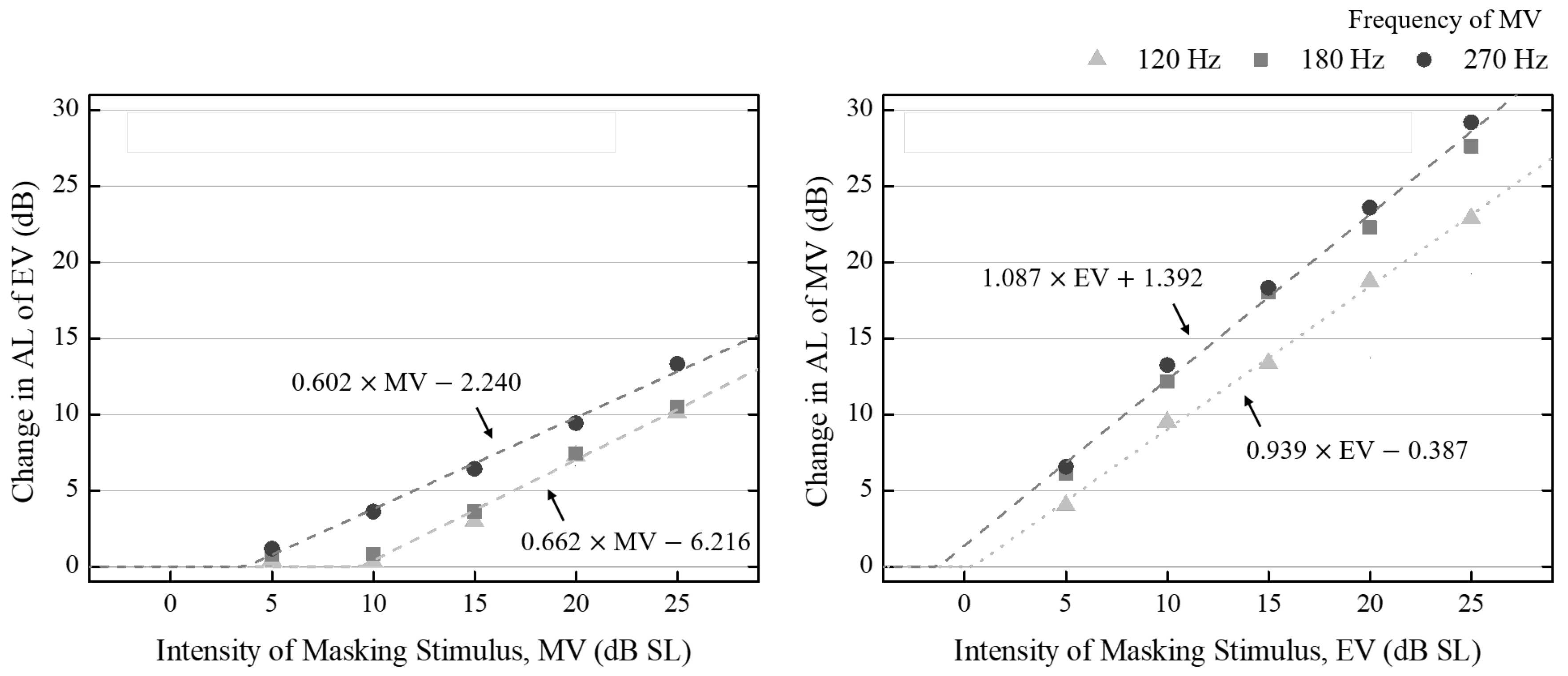
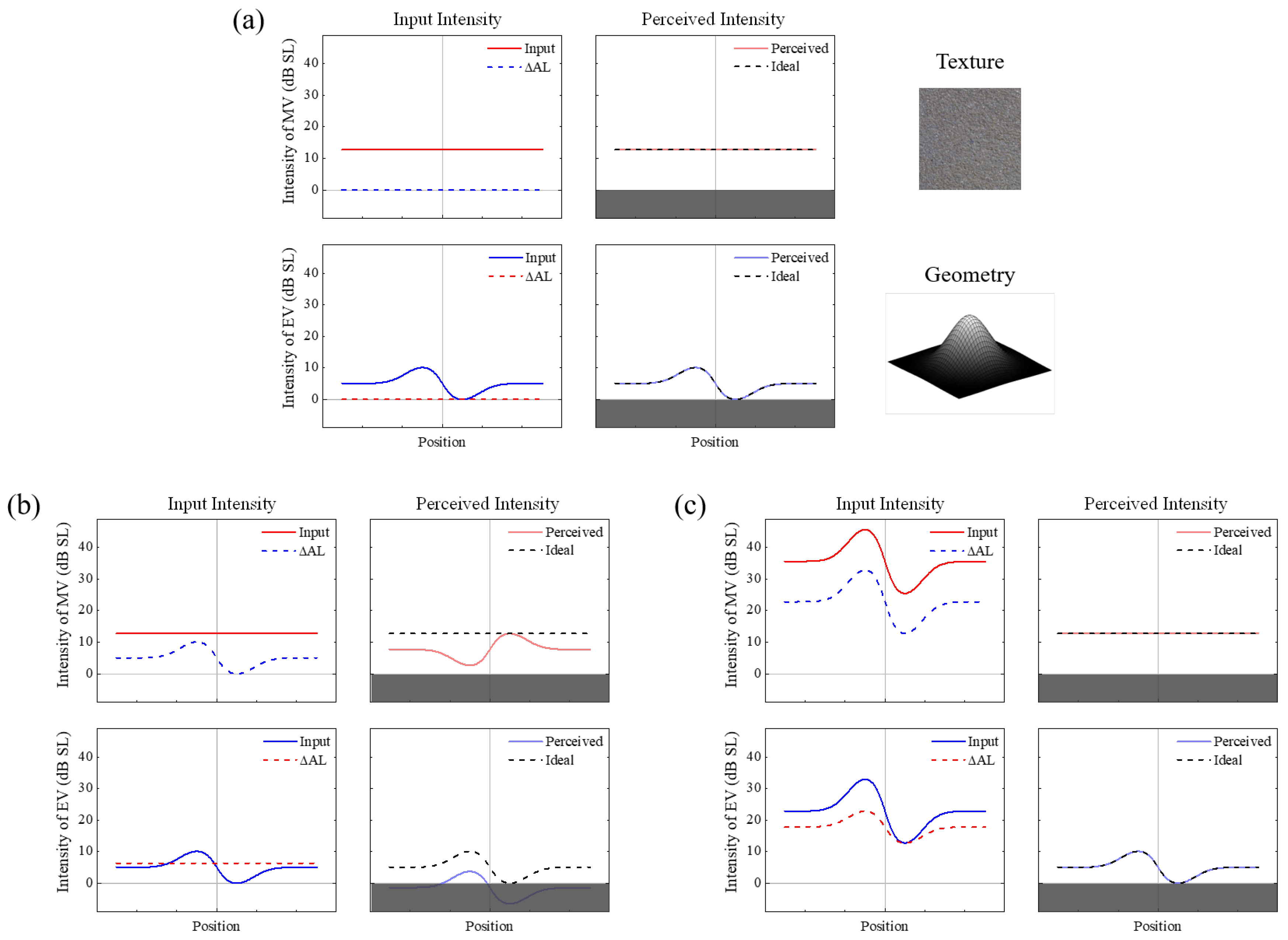
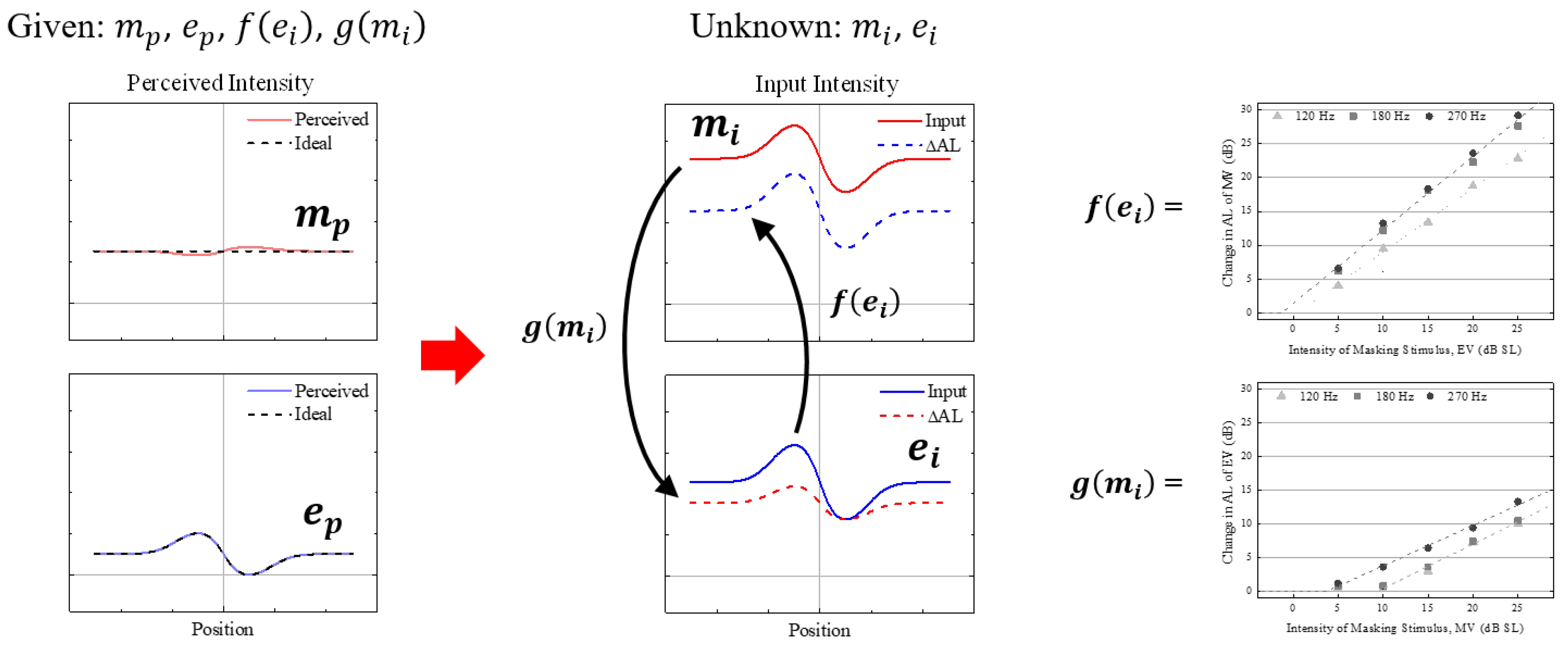
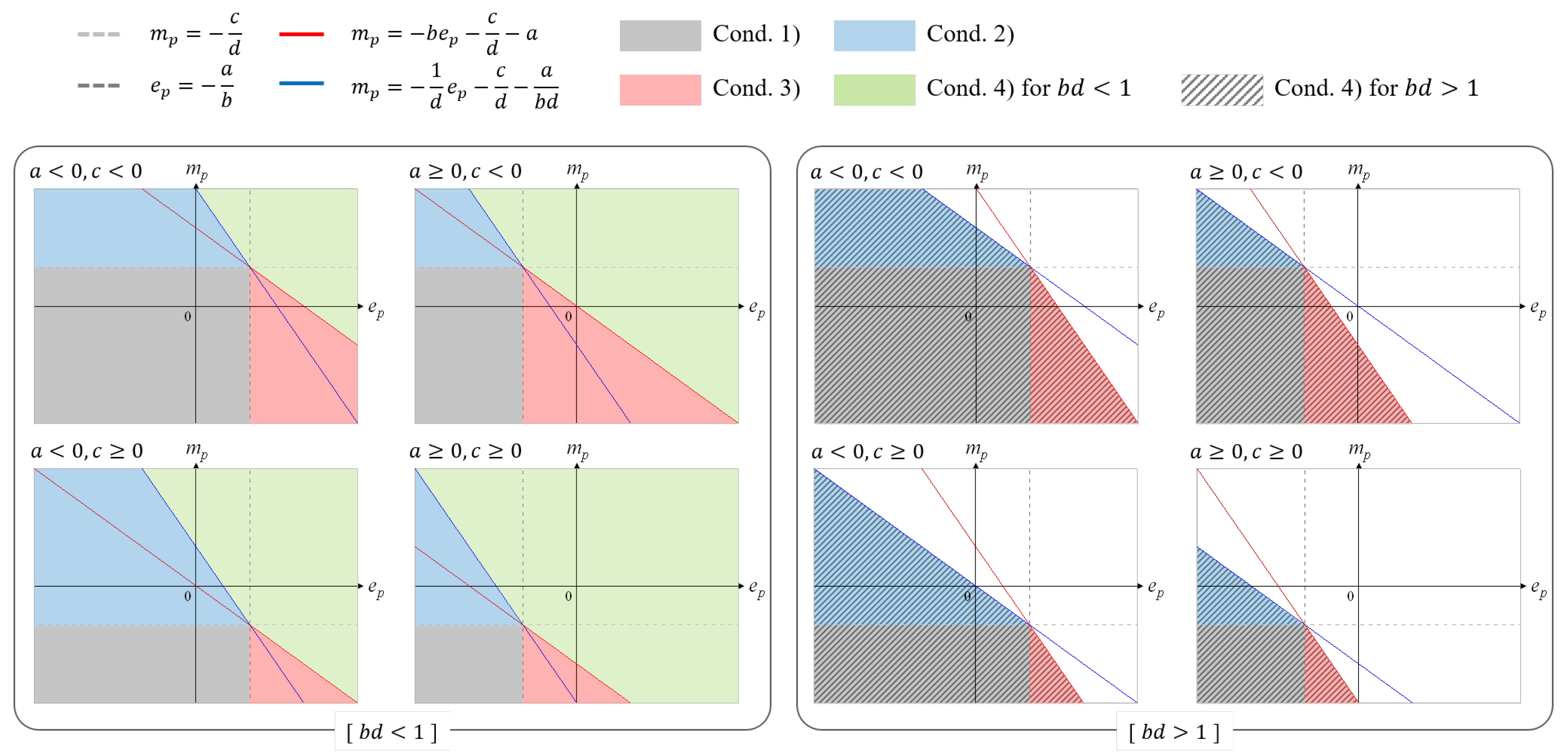

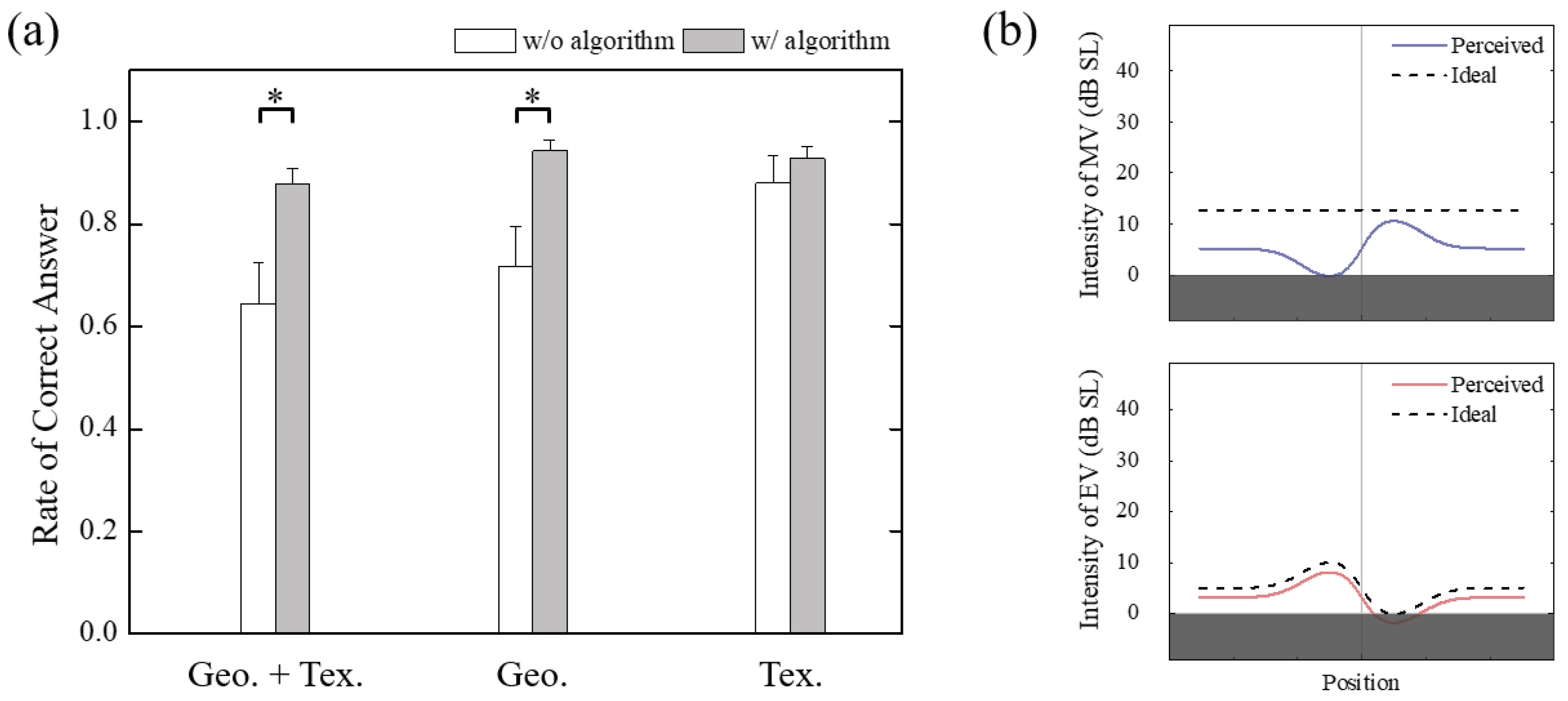
| Set 1–5 | Set 6–10 | Set 11–15 | ||
|---|---|---|---|---|
| Experiment I | Frequency of EV (Hz) | 270 | 270 | 270 |
| Frequency of masker, MV (Hz) | 120 | 180 | 270 | |
| Intensity of masker, MV (dB SL) | 5, 10, 15, 20, 25 | 5, 10, 15, 20, 25 | 5, 10, 15, 20, 25 | |
| Experiment II | Frequency of MV (Hz) | 120 | 180 | 270 |
| Frequency of masker, EV (Hz) | 270 | 270 | 270 | |
| Intensity of masker, EV (dB SL) | 5, 10, 15, 20, 25 | 5, 10, 15, 20, 25 | 5, 10, 15, 20, 25 |
| Target Stimulus | Masking Stimulus | Frequency of MV (Hz) | Masker Intensity (dB SL) | |||||
|---|---|---|---|---|---|---|---|---|
| 5 | 10 | 15 | 25 | 25 | ||||
| 120 | * 0.433 | * 0.322 | 2.992 | 7.265 | 10.107 | |||
| Experiment I | EV | MV | 180 | * 0.771 | * 0.808 | 3.611 | 7.427 | 10.502 |
| 270 | * 1.171 | 3.608 | 6.411 | 9.428 | 13.301 | |||
| 120 | 4.017 | 9.506 | 13.376 | 18.727 | 22.891 | |||
| Experiment II | MV | EV | 180 | 6.118 | 12.158 | 18.015 | 22.278 | 27.612 |
| 270 | 6.546 | 13.235 | 18.306 | 23.580 | 29.195 | |||
| Term | Description |
|---|---|
| perceived intensity of MV | |
| input intensity of MV required to produce | |
| perceived intensity of EV | |
| input intensity of EV required to produce | |
| masking function of MV | |
| masking function of EV |
| Condition () | Solution | Condition () | ||
|---|---|---|---|---|
| (1) | ||||
| (2) | ||||
| (3) | ||||
| (4) | ||||
| (4) |
© 2020 by the authors. Licensee MDPI, Basel, Switzerland. This article is an open access article distributed under the terms and conditions of the Creative Commons Attribution (CC BY) license (http://creativecommons.org/licenses/by/4.0/).
Share and Cite
Ryu, S.; Pyo, D.; Lim, S.-C.; Kwon, D.-S. Rendering Strategy to Counter Mutual Masking Effect in Multiple Tactile Feedback. Appl. Sci. 2020, 10, 4990. https://doi.org/10.3390/app10144990
Ryu S, Pyo D, Lim S-C, Kwon D-S. Rendering Strategy to Counter Mutual Masking Effect in Multiple Tactile Feedback. Applied Sciences. 2020; 10(14):4990. https://doi.org/10.3390/app10144990
Chicago/Turabian StyleRyu, Semin, Dongbum Pyo, Soo-Chul Lim, and Dong-Soo Kwon. 2020. "Rendering Strategy to Counter Mutual Masking Effect in Multiple Tactile Feedback" Applied Sciences 10, no. 14: 4990. https://doi.org/10.3390/app10144990
APA StyleRyu, S., Pyo, D., Lim, S.-C., & Kwon, D.-S. (2020). Rendering Strategy to Counter Mutual Masking Effect in Multiple Tactile Feedback. Applied Sciences, 10(14), 4990. https://doi.org/10.3390/app10144990





